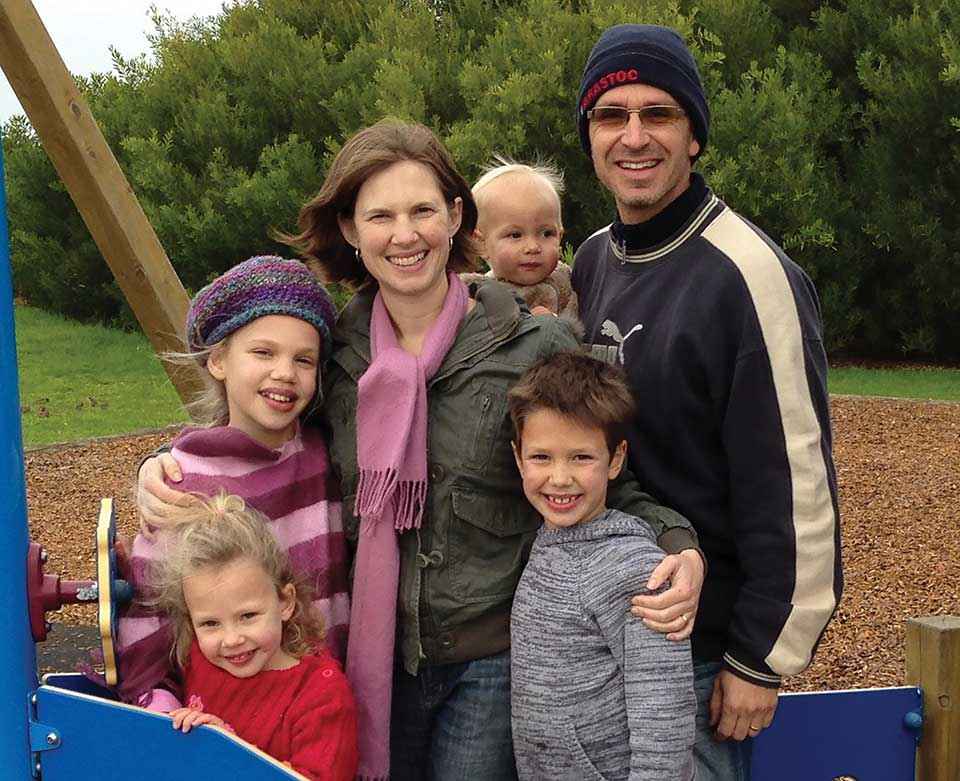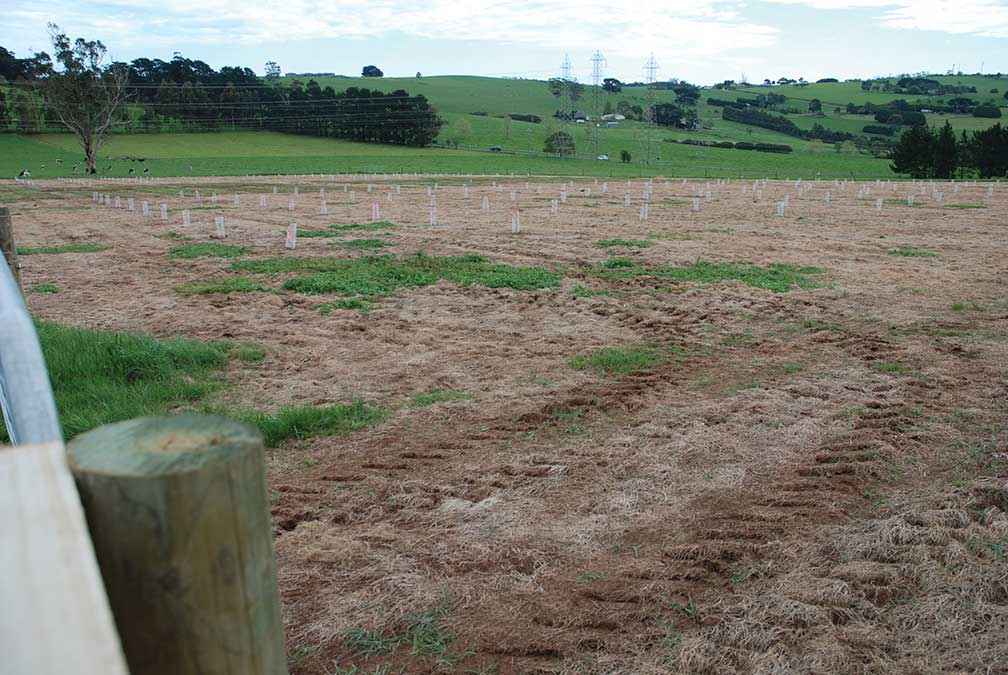Victorian Landcare Magazine - Spring 2018, Issue 73

Western Port Catchment Landcare Network
Clinton and Michelle Tepper purchased their 45-hectare beef farm at Buln Buln near Warragul in 2011. Clinton has worked as a forester since leaving university and has been involved with planting millions of trees on hundreds of different farms all over Victoria.
However, he would often become dispirited when he heard people complain about problems caused by trees on their farms – including weed and pest animal issues, fire, and falling trees damaging fences.
Clinton was determined to develop a practical method to add value to trees on farms while reducing some of the common problems they can cause.
In partnership with the Westernport Catchment Landcare Network (WPCLN), Clinton proposed a design for trees to be planted with a larger space between them, which would allow pastures, crops and cattle to better utilise the land around the trees to fill feed gaps and provide protection, while providing additional income opportunities.
"Clinton was determined to develop a practical method to add value to trees on farms while reducing some of the common problems they can cause."
Layers mimic a forest
The term ‘multi-storey farming’ came from Clinton’s trade as a forester where the top, middle and lower layers of a forest are referred to as storeys.
According to Clinton, the results were evident from the first planting.
“One crop we put in was huge with beautiful long seed heads. At this stage the trees were low, so the crop gave the trees fantastic protection,” Clinton said.
The system is continually changing in its physical appearance, with the early crops providing protection for the trees, followed by the trees growing and then providing shelter and cover for livestock and the crops.
“At this stage I realised what a dynamic system it was. A site might start with a particular crop but once the trees start to exert some shade influence, other crops will be better suited. The final result being totally different than at the beginning,” Clinton said.
The system is continually changing in its physical appearance, with the early crops providing protection for the trees, followed by the trees growing and then providing shelter and cover for livestock and the crops.
“At this stage I realised what a dynamic system it was. A site might start with a particular crop but once the trees start to exert some shade influence, other crops will be better suited. The final result being totally different than at the beginning,” Clinton said.
The system also allows for livestock grazing and for the pasture or crops between the rows to be harvested for hay, silage or grain.
Clinton stresses that the system is about optimising soil use and photosynthesis through using deeper reserves of soil and intercepting more sunlight, which creates a more robust and diverse system.
The multi-storey trial area on the Tepper’s property was established in 2014. A 1.2-hectare exposed location was selected – with the hope it could provide future shade and shelter for livestock. Clinton planted the trees in 13 rows, at 5.25 metres apart. Within the row trees were planted two metres apart.
A mix of silvertop ash, spotted gum and silver wattle were planted. Within one month of planting the trees different blends of pasture and cereal crops were planted in the rows between the trees. Cattle were first grazed on the site 14 months after planting and many times since.
It’s important to monitor the cattle and be responsive, but they choose to graze the crops and pastures in preference to the trees.
Four years after establishment, the results show that the system works. The trees have grown quickly and more than 70 different types of pasture and crops have been trialled. Clinton measures the trees regularly for height, diameter and form. The trees compare favourably with other forestry plantings of the same species in the region.
During the dry summer months, the demonstration area retained water. Several grass species have shown potential to grow significantly further into the dry season than conventional rye grass varieties. This will provide green feed for the cattle well into summer. Other grass, legume, cereal and fodder species are also growing strongly adjacent to the rapidly growing trees.

Above: The trial site in October 2014 immediately after tree planting.
Four years after establishment, the results show that the system works. The trees have grown quickly and more than 70 different types of pasture and crops have been trialled. Clinton measures the trees regularly for height, diameter and form. The trees compare favourably with other forestry plantings of the same species in the region.
During the dry summer months, the demonstration area retained water. Several grass species have shown potential to grow significantly further into the dry season than conventional rye grass varieties. This will provide green feed for the cattle well into summer. Other grass, legume, cereal and fodder species are also growing strongly adjacent to the rapidly growing trees.

Above: The trial site in December 2017 showing strong tree and pasture growth.
Positive soil results
The soils in the demonstration area are regularly analysed for nutrients, microbiology, moisture and bulk density. All ungrazed pasture and crop residues along with tree thinnings and prunings are mulched on the surface to be broken down by the soil.
Soil test results in the trial area, compared to the control plot, show good nitrogen levels and decreased sodium. Soil microbes play an important role in the multi-storey farming system. They help decompose organic matter such as grass, leaves and thinnings into nutrients and stable humus compounds. Soil microbes also provide services such as nitrogen fixation and plant disease suppression and produce products that stimulate plant growth and help solubilise nutrients from soil mineral particles.
"The system is continually changing in its physical appearance, with the early crops providing protection for the trees, followed by the trees growing and then providing shelter and cover for livestock and the crops."
Results indicate significant increases in total microorganisms, total bacteria, fungi and mycorrhiza in the trial site compared with the control. This indicates that the mulched biomass, produced by tree management activities (pruning and thinning) is having a positive impact on soil microbial populations.
The multi-storey farming concept that Clinton and Michelle have created can be applied to other types of trees, including fruit and nut trees, and the grazing of chickens, pigs, sheep or other animals. It can also be adapted to suit any farm of any size.
Clinton’s design is relatively simple – plant the trees further apart and use the additional space between the trees for crops, pasture and/or livestock. This system allows for a natural symbiosis to occur, improving sustainability and productivity.
“The demonstration trial is changing the direction of where we’re going with the farm,” Clinton said.
Peter Ronalds is the Sustainable Agriculture Manager for the Western Port Catchment Landcare Network.
For further information email peter@wpcln.org.au or go to:
Practical Landcare Guide – Multi Storey Farming brochure http://www.wpcln.org.au/wp-content/uploads/2018/05/MSF-Brochure_Print.pdf
Below is a link to a detailed case study on the Multi Storey Farming demonstration which has lots of photos & information http://www.wpcln.org.au/wp-content/uploads/2018/07/Multi-Storey-Farming-case-study-report.pdf
Access the magazine's index to search for other stories by author, title, and subject, here.
Above: Clinton Tepper talks about multi storey farming